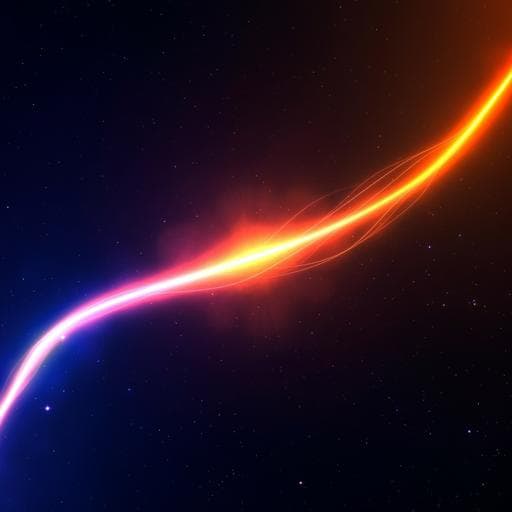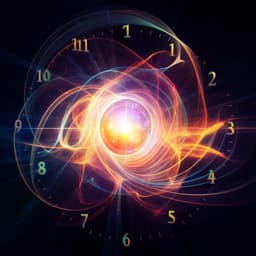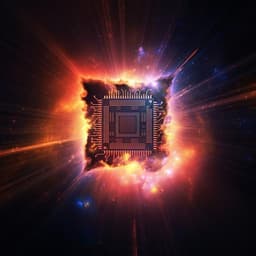
Physics
Noiseless single-photon isolator at room temperature
S. Zhang, Y. Zhan, et al.
Discover groundbreaking research by Shicheng Zhang, Yifan Zhan, Shangqing Gong, and Yueping Niu on a noiseless, all-optical isolator utilizing single photons in hot atoms. This innovative device achieves exceptional isolation and low insertion loss, demonstrating remarkable reversibility and robustness—all at room temperature.
~3 min • Beginner • English
Introduction
The study addresses how to realize magnetic-free optical nonreciprocity (ONR) that operates in the quantum regime without adding noise to single photons. Reciprocity from time-reversal symmetry makes optical nonreciprocity challenging. Traditional Faraday-based isolators require bulky magneto-optical materials and strong magnetic fields, which limit on-chip and magnetically sensitive quantum applications. Prior magnetic-free approaches (nonlinear effects, spatiotemporal modulation, optomechanics, moving atomic Bragg lattices, chiral systems, and thermal-motion-induced effects) largely demonstrated ONR with classical light. For quantum applications, ONR must function with genuine single photons and preserve their quantum statistics, avoiding both classical background and quantum noise. Previous experimental single-photon ONR (e.g., ladder-type EIT) required strong drives in hot atoms, introducing background and quantum noise through nonlinear processes and drive amplitude/phase fluctuations. The authors propose and demonstrate a noiseless nonreciprocal scheme using incoherent optical pumping with hot atoms, exploiting velocity-selective population transfer to create direction-dependent absorption. Because the pump is weak and spectrally far from the single-photon signal, classical background can be strongly suppressed, and the incoherent process avoids quantum noise transfer. The device achieves low insertion loss (≈0.6 dB), high isolation (30.3 dB), bandwidth of hundreds of MHz, and reversible nonreciprocity by changing the pump detuning sign, all at room temperature.
Literature Review
The paper reviews magnetic-free ONR mechanisms including optical nonlinearities, space-time permittivity modulation, optomechanical interactions, moving Bragg lattices in atoms, chiral quantum systems, and thermal-motion-induced nonreciprocity. While many schemes function with classical weak coherent light, extending ONR to genuine single photons is challenging due to drive-induced classical and quantum noise. The only prior experimental single-photon ONR used ladder-type EIT, which in hot atoms requires strong drive fields leading to noise via nonlinear parametric processes and conversion of drive phase noise to amplitude noise. A recent proposal using incoherent pumping reduced drive-induced noise but had only been tested with weak coherent and pseudothermal light, not genuine single photons. This work fills that experimental gap.
Methodology
Concept and mechanism: Use an open V-type level scheme in hot 87Rb to achieve ONR via velocity-selection-based incoherent optical pumping. A pump laser (propagating +x) couples |5^2S1/2, F=1> to |5^2P3/2, F=1>, making it red detuned from |5^2P3/2, F=2> by Δp = 2π×157 MHz. Due to Doppler shifts, atoms with velocity v=Δp/k are resonantly pumped out of the ground state |F=1> to the metastable |5^2S1/2, F=2>, creating an asymmetric ground-state population for opposite velocity classes. Single-photon signals (Anti-Stokes) on the |5^2S1/2, F=1> ↔ |5^2P1/2, F=2> transition propagate either forward (+x) or backward (−x) with detuning Δs. When Δs=Δp, forward-propagating photons encounter an emptied ground-state velocity class and transmit with minimal absorption, while backward photons interact with a populated class and are absorbed, producing nonreciprocity. Reversing the sign of Δp reverses the direction of isolation without changing the signal frequency.
Single-photon source: Heralded photon pairs (Stokes/Anti-Stokes) are generated via spontaneous four-wave mixing in a paraffin-coated hot 87Rb vapor cell using two counter-propagating coupling lasers: 780 nm (Coupling 1) red detuned by 2π×2.7 GHz from |5^2S1/2, F=1>→|5^2P3/2, F=2>, and 795 nm (Coupling 2) red detuned by 2π×157 MHz from |5^2S1/2, F=2>→|5^2P1/2, F=2>. Coupling powers: 10 mW (780 nm) and 40 mW (795 nm). Both beams have 1/e^2 diameter 2.4 mm. Photon collection uses opposing single-mode fibers (collection efficiencies ≈78% and 75%) at a small angle (0.5°). The Rb vapor cell length is 7.5 cm, heated to 40 °C. Stokes photons are filtered by a 780 nm narrowband filter and a Fabry–Perot etalon (85% T, 60 MHz BW) before detection (Excelitas SPCM-AQRH-16-APC). The Anti-Stokes photons are heralded and used as the probe for ONR tests.
ONR medium and pump: A second 87Rb vapor cell (7.5 cm, 80 °C) serves as the nonreciprocal medium. A narrow-linewidth 780 nm pump laser (vertical polarization) is applied along +x; the polarization beam splitter (≈35 dB extinction) reflects the pump. The Anti-Stokes single photons traverse the cell forward or backward. Additional filtering for Anti-Stokes detection includes a 795 nm narrowband filter and a Fabry–Perot etalon (90% T, 60 MHz BW). Combined polarization control, single-mode fiber coupling, and spectral filtering suppress the pump field by up to 120 dB, enabling genuine single-photon measurements.
Measurements: First, a weak coherent probe scans forward/backward transmission spectra versus detuning to characterize the transmission peak near Δk=2π×157 MHz and its dependence on pump power. Then, genuine single-photon performance is characterized by coincident counting of heralded Anti-Stokes photons for forward/backward propagation. Single-photon transmission T is defined from total integral coincidence counts (T = CC(b)/CCin). Bandwidth of the transmission peak is extracted versus pump power. Noise characterization includes: (i) second-order cross-correlation g^(2)(τ) between Stokes and Anti-Stokes; (ii) heralded autocorrelation α = P123/(P12 P13) to quantify single-photon purity (α<0.5 indicates near-single-photon); (iii) Cauchy–Schwarz parameter R to assess nonclassical correlations. Classical background is measured by blocking the signal while leaving the pump on. The single-photon linewidth is inferred from the Fourier transform of g^(2)(τ)−1 (≈2π×7.3 MHz). Reversibility is tested by changing the pump detuning from +157 MHz to −157 MHz at fixed pump power (40 mW) and temperature (80 °C) without changing the signal frequency.
Key Findings
- Demonstrated a magnetic-free, noiseless single-photon optical isolator at room temperature using velocity-selective incoherent optical pumping in hot 87Rb.
- Forward transmission (single photons) increased from 45.3% to 87.1% as pump power increased from 5 mW to 40 mW; backward transmission remained near zero.
- Achieved ultralow insertion loss ≈0.6 dB and high isolation ≈30.3 dB at 40 mW pump power.
- Transmission bandwidth (weak probe) broadened from 2π×43 MHz to 2π×175 MHz with increasing pump power; the maximum bandwidth is ~24× the heralded single-photon linewidth (~2π×7.3 MHz), ensuring high transmission without spectral distortion.
- Quantum-statistics preservation: forward g^(2)(τ) slightly exceeds input due to spectral filtering; backward g^(2)(τ) ≈ 1 indicating destroyed correlations.
- Heralded autocorrelation α (single-photon purity): input α = 0.091±0.004; forward α = 0.093±0.007 (no degradation).
- Cauchy–Schwarz nonclassicality: Rinput = 127; Rforward = 129; Rbackward = 0.27.
- Classical background with pump only leads to accidental coincidences <0.1%.
- Reversible nonreciprocity: flipping pump detuning from +157 MHz to −157 MHz reverses isolation direction with the same signal frequency and comparable performance; the required frequency shift (hundreds of MHz) is readily achieved with an AOM.
Discussion
The work addresses the challenge of achieving optical nonreciprocity suitable for quantum applications by eliminating drive-induced noise that typically accompanies coherent-drive schemes in hot atoms. By employing incoherent, velocity-selective optical pumping with modest pump power and a large spectral separation between pump and signal, the device produces direction-dependent absorption while avoiding both classical background and quantum noise transfer to the single-photon signal. As a result, the quantum statistical properties of heralded single photons are preserved in the transmitting direction (unchanged α and R), while correlations are strongly suppressed in the blocked direction. The broad, tunable nonreciprocal bandwidth (hundreds of MHz) relative to the narrow single-photon linewidth ensures low insertion loss and robustness against spectral variations. Reconfigurability is demonstrated by reversing the isolation direction via a sign change of pump detuning without altering the signal frequency or device configuration. These features make the scheme practical for integration into quantum communication networks and on-chip photonic platforms where magnetic fields are undesirable.
Conclusion
The authors demonstrate a room-temperature, magnetic-free, noiseless single-photon isolator based on velocity-selective incoherent optical pumping in hot 87Rb. The device achieves ≈0.6 dB insertion loss, ≈30.3 dB isolation, and a nonreciprocal bandwidth of hundreds of MHz, while preserving single-photon quantum statistics in the transmitting direction. The isolation direction can be reversed by tuning the pump detuning sign without changing the signal frequency. Owing to its simplicity, robustness, and compatibility with miniaturized hot-atom platforms and integrated waveguides, the approach is promising for quantum networking and integrated quantum information processing.
Limitations
Related Publications
Explore these studies to deepen your understanding of the subject.







